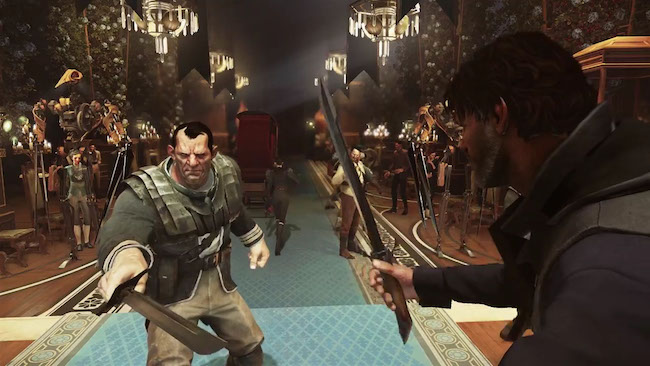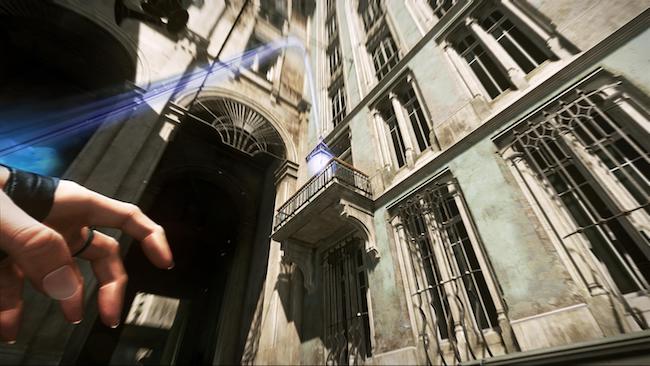
While a lot has changed between the first and second Dishonored games, there are some things which haven’t. Dunwall has indeed prospered under Empress Emily Kaldwin’s reign, who, subsequently, has been training with her father Corvo to ensure she doesn’t meet the same ill-fated end as her mother. However, like always, trouble still lurks in the shadows. The world is still corrupt and people are still dying, and a serial murderer dubbed the “Crown Killer” has been systematically murdering all who oppose Emily, with many suspecting that she and Corvo may be behind it.
Fifteen years has passed since the events of Dishonored, and Emily, Corvo, and the city of Dunwall are celebrating the anniversary of Empress Jessamine Kaldwin’s assassination, an event Emily sees as both confusing and insensitive. Regardless, she follows along with the rituals and celebrations, accepting condolences from the other city’s lords and ladies, as well as gifts of respect towards the late Empress Jessamine. That is until Mortimer Ramsey, an officer of the Dunwall City Watch, informs her that the Duke of Serkonos is coming, and with that, his “clockwork soldiers.”
After a brief interaction between the Duke and Emily, the Duke reveals he has a gift. A woman named Delilah who claims to be Jessamine’s half-sister, and announces that she is the rightful Empress of Dunwall and orders the soldiers to kill all of Emily’s guards. Corvo tries to protect Emily by using his powers to fight off the Duke’s men, but Delilah traps Corvo and steals his powers. Depending on who you decide to play as, the player character will be locked away while the other is frozen Han Solo style in a carbonite-like material.

A nice touch to the opening is that there is a little backstory for both Emily and Corvo which explains their fighting style and is intended to assist when choosing who to play as. I picked Emily as she is the new playable character and seemed to have a more interesting story to tell (no offence to any Corvo fans). After escaping Dunwall and choosing whether or not to receive The Outsider’s mark (a “no powers” playthrough option), you venture off plot your revenge against Delilah and the Duke, prancing around the world with your fancy clothes, folding knife and shiny gun.
While there are many different ways you can play through Dishonored 2, there are still two overarching approaches like with the original game. “Low Chaos,” which revolves around stealth and non-lethal combat tactics, and “High Chaos,” which is a more assault-focused route where killing is mostly inconsequential. Ultimately, though, this is only one piece of a bigger picture, so you don’t need to worry whether or not it will determine the exact outcome of the ending – that is just as much based on the choices you make in-game, many of which are not necessarily black or white. Unless you’re aiming for a particular type of playthrough for a trophy or personal goal, you don’t need to be afraid to kill a few people or to mix things up a bit based on what you think is best.
Personally, I prefer a higher chaos route, which is, unfortunately, a bit clunky when compared to a more stealthy playthrough. More than once while using Emily’s “Far Reach” ability (an equivalent to Corvo’s “Blink” power, though not as good), I ended up dying or severely hurt from fall damage. Even though the on-screen marker showed I would appear in one spot, I would sometimes instead land slightly off centre and fall. Emily’s other abilities seem to work a lot smoother, but are also more attuned to stealth, such as “Shadow Walk” and “Mesmerize.” “Domino” (where you can link several enemies, and have the action on one affect them all) is particularly fun to experiment with, though none of Emily’s powers are quite as useful in direct combat like Corvo’s “Devouring Swarm.”

Coming from playing the first game on PC to the sequel on PS4, it certainly took a bit of time to get used to playing with a controller; though it works well enough for the most part. It’s just the camera can be a little clumsy while shooting, with the sensitivity either feeling too sensitive or so slow it’s like there’s a delay in your movement. Walking around the city works smoothly enough, though; it’s more so aiming with the gun or one-handed crossbow that can be troublesome (even with aim assist turned on). All the same, you’ll still feel like a skilled swordmaster when fighting and blocking enemy attacks. There is an upgrade to the sword where you can deflect bullets, and you really do feel like a Victorian Jedi, unstoppable by any man. The gun also packs a punch, which is complimented by a slight kickback when shooting and a distinct loud bang (which, handy tip, isn’t helpful for a stealth playthrough).
While your objectives are clear right away, the narrative doesn’t get very engaging until a few hours in. In the beginning, it essentially feels like you’re a robot, much like the Duke’s clockwork soldiers, instructed to go to one place after the other, picking off people that serve as breadcrumbs to your ultimate goal: to take your castle back and dethrone Delilah. It also feels very rushed in the opening hours as the game tries to handle a lot of the big plot points at once. The point where it starts to pick up is once Emily begins to show the side of herself that is influenced by your actions. As I ended up playing through high chaos, Emily’s personality began to shine through her actions, how she would talk about her relationship with other characters, as well as her views on the world. Emily feels like a character that has a lot to offer, and Arkane Studios nailed that with great voice acting and interesting character interactions. When she’s talking with someone, it actually feels like a real conversation. That is, if you were in a Victorian steampunk world full of robot soldiers that look a bit like the droids from Star Wars. But I digress.
Playing so chaotically, the characters Emily interacted with began to almost feel a sort of dislike towards her, speaking negatively toward to her in conversation. One conversation I remember in particular that demonstrated this shift well is with a character called Megan, the captain of a ship called The Dreadful Wale, and Emily/Corvo’s home between missions. Emily and Megan are on the boat set out towards one of Emily’s many missions, and they both begin to discuss what Emily is going to do once she gets to her end goal. Playing through with high chaos meant Megan looked at Emily as if she was a high brow upper-class woman who has no respect for those in lower-class. Emily’s response to this I thought was perfect. Emily had, at this point, began to lean towards a cynical look on the world and commented how when becoming a leader, that you only deserve to keep your throne if you’re ready to roll out a red carpet of blood before it. Something about that line seems chilling but so well executed, and I thought it was an excellent example of the impact that your actions can have on the lead character and those around them.

One of the strongest components of Dishonored 2 is the level design. There is always more than one way to overcome any obstacle you’ll encounter, intended by the developers or otherwise. Not to mention a plethora of optional exploration, if you’re curious enough. This not only provides players with multiple pathways to consider at any given moment but also a lot of room for creativity no matter your playstyle. It always feels as if there is some sort of nook, cranny or rooftop just within your reach that you can use to navigate to your intended destination with ease. However, unlike many other games, these options are never so obvious that it cheapens the experience, or feels like there is a particular route that you’re probably meant to follow.
The rooftops and shadows aren’t the only highlights of the world. The streets themselves are made so even just with Emily’s Far Reach or sprint, you can avoid guards almost completely. Dogs, on the other hand, are a whole other story. About halfway, the game introduces Wolfhounds; enemies that aren’t new the Dishonored franchise but are nonetheless any easier to get by. Using their keen sense of smell they can sniff out the player. Even if they just catch a glimpse of you sneaking by, they will walk on over and attempt to expose you, which can be real bone chilling when you’re hiding in the shadows, and there is a dog just around the other side of a pillar that could find you.
Visually, the game is very similar to its predecessor in terms of the art style. However, Karnaca (the city in which Dishonored 2 primarily takes place) is a much more captivating and exciting place to explore when compared to the drab and dreary tone of Dunwall. The game generally looks and sounds fantastic, too, with lots of colour as well as great lighting, sound design, and music. What is frustrating, though, is that the performance when using the menus can be problematic. There are odd framerate issues, and it’s generally clunky and slow to navigate. And speaking of slow, Dishonored 2 can be painfully slow to load. It’s great that there are quick save/load options, but in a game that implores so much experimentation, the long load times will frequently break your immersion.

While Dishonored 2 is fundamentally more of the same, almost everything about it has has been improved over its predecessor. The characters feel more alive and are supported by well-written dialogue that is full of small but impactful nuances, as well as a narrative, that, while slow to start, works really well. Dishonored 2 is also gorgeous, introducing a lot more colour that makes Karnaca a much more fascinating city to explore. The biggest quality driving Dishonored 2, however, is how much freedom it gives players. There are so many ways you can play the game, both in style and in direction, and it is emphasised that there is no right or wrong way. Whether it’s action or stealth, lethal or non-lethal, you can play the way you want to play and get creative with experimentation. There are small things I could nitpick over, like the menus and loading times, or how the controls don’t handle well under pressure, but it’s mostly negligible in the big picture. It’s simply a fun game, and with so much replayability, you’re bound to have a great time.











